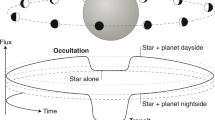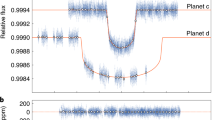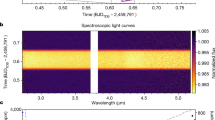Abstract
Characterization studies now have a dominant role in the field of exoplanets. Such studies include the measurement of an exoplanet's bulk density, its brightness temperature and the chemical composition of its atmosphere. The use of space telescopes has played a key part in the characterization of transiting exoplanets. These facilities offer astronomers data of exquisite precision and temporal sampling as well as access to wavelength regions of the electromagnetic spectrum that are inaccessible from the ground. Space missions such as the Hubble Space Telescope, Microvariability and Oscillations of Stars (MOST), Spitzer Space Telescope, Convection, Rotation and Planetary Transits (CoRoT), and Kepler have rapidly advanced our knowledge of the physical properties of exoplanets and have blazed a trail for a series of future space missions that will help us to understand the observed diversity of exoplanets.
This is a preview of subscription content, access via your institution
Access options
Subscribe to this journal
Receive 51 print issues and online access
$199.00 per year
only $3.90 per issue
Buy this article
- Purchase on Springer Link
- Instant access to full article PDF
Prices may be subject to local taxes which are calculated during checkout


Similar content being viewed by others
References
Baglin, A. The CoRoT satellite in flight: description and performance. Adv. Space Res. 31, 345–349 (2003).
Deleuil, M. et al. Transiting exoplanets from the CoRoT space mission. XX. CoRoT-20b: a very high density, high eccentricity transiting giant planet. Astron. Astrophys. 538, A145 (2012).
Alonso, R. et al. Transiting exoplanets from the CoRoT space mission. II. CoRoT0-Exo-2b: a transiting planet around an active G star. Astron. Astrophys. 482, L21 (2008).
Walker, G. A. H. et al. MOST detects variability on τ Bootis a possibly induced by its planetary companion. Astron. Astrophys. 482, 691 (2008).
Deeg, H. J. et al. A transiting giant planet with a temperature between 250 K and 430 K. Nature 464, 384–387 (2010).
Demory, B.-O. & Seager, S. Lack of inflated radii for Kepler giant planet candidates receiving modest stellar irradiation. Astrophys. J. 197 (Suppl.), 12 (2011).
Deleuil, M. et al. Transiting exoplanets from the CoRoT space mission. VI. CoRoT-Exo-3b: the first secure inhabitant of the drown-dwarf desert. Astron. Astrophys. 491, 889 (2008).
Leger, A. et al. Transiting exoplanets from the CoRoT space mission. VIII. CoRoT-7b: the first super-Earth with measured radius. Astron. Astrophys. 586, 278 (2009). This paper reports the discovery of the first transiting rocky super-Earth exoplanet.
Hatzes, A. P. et al. The mass of CoRoT-7b. Astrophys. J. 743, 75 (2011).
Batalha, N. et al. Kepler's first rocky planet. Astrophys. J. 729, 27 (2011).
Sanchis-Ojeda, R. et al. Transits and occultations of an Earth-sized planet in an 8.5-hour orbit. Astrophys. J. 774, 54 (2013).
Howard, A. W. et al. A rocky composition for an Earth-sized exoplanet. Nature 503, 381–384 (2013).
Pepe, F. et al. An Earth-sized planet with an Earth-like density. Nature 503, 377–380 (2013). Together with ref. 12, this paper reports the discovery of the first transiting rocky Earth-sized exoplanet.
Rowe, J. et al. The very low albedo of an extrasolar planet: MOST space-based photometry of HD 209458. Astrophys. J. 689, 1345 (2008).
Winn, J. N. et al. A super-Earth transiting a naked-eye star. Astrophys. J. 737, L18 (2011).
Brown, T. M., Charbonneau, D., Gilliland, R. L., Noyes, R. W. & Burrows, A. Hubble Space Telescope time series photometry of the transiting planet of HD 202458. Astrophys. J. 552, 699 (2001).
Charbonneau, D., Brown, T. M., Noyes, R. W. & Gilliland, R. L. Detection of an extrasolar planetary atmosphere. Astrophys. J. 568, 377 (2002).
Vidal-Madjar, A. et al. An extended upper atmosphere around the extrasolar planet HD 209458b. Nature 422, 143–146 (2003).
Vidal-Madjar, A. et al. Magnesium in the atmosphere of the planet HD209458 b: observations of the thermosphere-exosphere transition region. Astron. Astrophys. 560, A54 (2013).
Ben-Jaffel, L. & Ballester, G. E. Hubble Space Telescope detection of oxygen in the atmosphere of exoplanet HD 189733b. Astron. Astrophys. 553, A52 (2013).
Swain. M.R. et al. Water, methane, and carbon dioxide present in the dayside spectrum of the exoplanet HD 209458b. Astrophys. J. 704, 1616 (2009)
Swain, M. R., Vasisht, G. & Tinetti, G. The presence of methane in the atmosphere of an extrasolar planet. Nature 452, 329–331 (2008).
Gibson, N. P., Pont, F. & Aigrain, S. A new look at NICMOS transmission spectroscopy of HD 189733, GJ-436 and XO-1: no conclusive evidence for molecular features. Mon. Not. R. Astron. Soc. 411, 2199 (2011).
Csizmadia, S. Pasternacki, Th., Dreyer, C., Cabrera, J., Erikson, A., Rauer, H. The effect of stellar limb darkening values on the accuracy of the planet radii derived from photometric transit observations. Astron. Astrophys. 549, A9 (2013).
Pont, F. et al. The prevalence of dust on the exoplanet HD 189733b from Hubble and Spitzer observations. Mon. R. Astron. Soc. 432, 2917 (2013).
Kreidberg, L. et al. Clouds in the atmosphere of the super-Earth exoplanet GJ 1214b. Nature 505, 69 (2014).
Knutson, H. A., Benneke, B., Deming, D. & Homeier, D. A featureless transmission spectrum for the Neptune-mass exoplanet GJ 436b. Nature 505, 66–68 (2014).
Knutson, H. A. et al. A map of the day-night contrast of the extrasolar planet HD 189733b. Nature 447, 183–186 (2007). This paper documents the first brightness map of an exoplanet.
Snellen, I. A. G. de Mooij. Ernst, J.W. & Albrecht, S. The changing phases of extrasolar planet CoRoT-1b. Nature 459, 543–545 (2009).
Sudarsky, D., Burrows, A. & Hunbeny, I. Theoretical spectra and atmospheres of extrasolar giant planets. Astrophys. J. 588, 1121 (2003).
Demory, B.-O. et al. The high albedo of the Hot Jupiter Kepler-7b. Astrophys. J. 197, 12 (2011).
Demory, B.-O. et al. Detection of a transit of the super-Earth 55 Cancri e with Warm Spitzer. Astron. Astrophys. 533, A114 (2011).
Demory, B.-O. et al. Detection of a thermal emission from a super-Earth. Astrophys. J. 751, L28 (2012).
Rauer, H. et al. The PLATO 2.0 Mission. Exp. Astron. (submitted); preprint at http://arxiv.org/abs/1310.0696 (2014).
Acknowledgements
The author would like to warmly thank H. Rauer, J. Cabrera and S. Csizmadia for their valuable comments.
Author information
Authors and Affiliations
Corresponding author
Ethics declarations
Competing interests
The author declares no competing financial interests.
Additional information
Reprints and permissions information is available at www.nature.com/reprints.
Rights and permissions
About this article
Cite this article
Hatzes, A. The role of space telescopes in the characterization of transiting exoplanets. Nature 513, 353–357 (2014). https://doi.org/10.1038/nature13783
Received:
Accepted:
Published:
Issue Date:
DOI: https://doi.org/10.1038/nature13783
This article is cited by
-
Transiting Exoplanet Discovery Using Machine Learning Techniques: A Survey
Earth Science Informatics (2020)
Comments
By submitting a comment you agree to abide by our Terms and Community Guidelines. If you find something abusive or that does not comply with our terms or guidelines please flag it as inappropriate.



